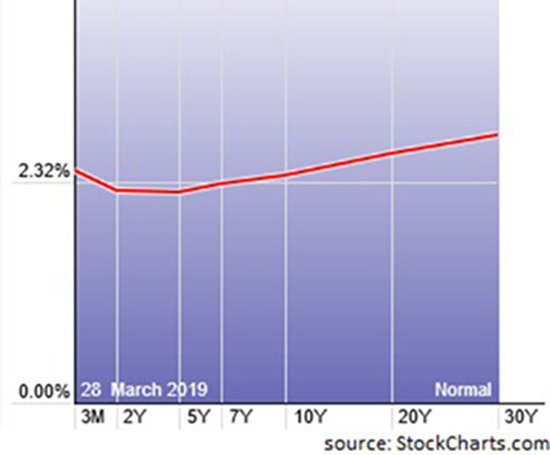The financial press is rife with warnings that the yield curve inversion is about to bring on a recession.
That's only partially true, at best.

It is true that when short-term interest rates rise above long-term rates - called a yield curve inversion - that a recession is likely to follow.
But the same history shows us that it takes more than a year before it actually happens. That means there is still plenty of opportunity for smart investors to bank some big profits while everyone else panics.
Plus, people who actually know what they're talking about aren't even sure this is a true inversion...
Did the Yield Curve Invert?
Before we even get into what to do about an inverted yield curve, we have to establish that the curve is actually inverted at all. This week, the chicken littles in the media fell all over themselves to report that the curve inverted. But did it?
It is true that the three-month Treasury rate moved up to 2.42%, which is higher than the 10-year rate at 2.41%. It was actually a bit more pronounced earlier in the week, so right away we can see that this was more of a short-term anomaly than a signal of bad things to come.
This Could Be the Most Profitable Dollar You Ever Spend: Tom Gentile's Cash Course covers all the essential trading ideas you need to know to potentially make thousands in extra income every week. Get access for $1...
However, most market experts don't consider the yield curve to be inverted until the two-year rate rises above the 10-year rate. Right now, the two-year is at 2.25%, well below the 10-year rate.
Take a look at this chart, which shows the very short end of the curve slightly above the rest. For the most part, the curve is not yet inverted.

This is why smart investors do their own homework and take guidance from respected experts.
And this is what the experts are saying...
The Fed Is the Wild Card
Remember who, or what, controls each part of the yield curve. The short end is highly dependent on the U.S. Federal Reserve and whatever policy it chooses to follow. Fed Chair Jerome Powell has already said that the Fed will not pursue a rate hike strategy this year, so whatever is happening to the yield curve now does not have real staying power.
In fact, traders believe him. Federal funds futures trading on the Chicago Mercantile Exchange continue to show zero chance of a Fed rate hike in 2019, according to experts who crunch the odds.
Making it even more interesting is the fact that the President's nominee for a Fed post, Stephen Moore, has already called for the Fed to slash short-term rates.
On the other side, the long end of the curve is controlled by the market, inflation, and growth prospects. Fed policy only has a tangential effect on where long-term rates go, and right now, that portion of the yield curve looks fairly normal.
To be sure, fairly normal is not necessarily bullish for the economy. Rates peaked last November and have been heading lower ever since. That's not a great sign for economic growth, but by itself, it is not a harbinger for a recession.
That means investors have plenty of time to cash in before a recession hits and sends stocks tumbling.
Here's what you can do...
How to Profit Before the Recession
[mmpazkzone name="in-story" network="9794" site="307044" id="137008" type="4"]
Setting aside convention, let's assume that the current state of the yield curve is actually inverted. Bloomberg found it takes an average of 627 days from inversion to recession. That means the next recession could start in November 2020.
This is borne out in market action, too. Ralph Vince, President of Vince Strategies LLC, found that the process of inversion of the curve is actually bullish for stocks. Indeed, the long period of exceptionally low rates in general actually sets the table for a long period of inversion to exist before the economy actually feels the effects.
This means you have a big opportunity to profit while others panic.
When the majority of investors decide that an inverted yield curve is bad and they start selling their stocks, the resulting soft market sets up substantial opportunity before the recession actually arrives. It won't last forever, but it does not have to in order to set up big profit opportunities.
And one of the best ways to cash in is by knowing how to trade options...
You Can Learn How to Trade Like the Pros - for Just $1
America's No. 1 Pattern Trader, Tom Gentile, is giving you a rare opportunity to learn how to amass a constant stream of extra cash - year in and year out.
And he's going to teach you how to do it entirely on your own.
People have paid up to $30,000 to access his secrets... but it can all be yours for only $1.
Go here to claim your seat in America's No. 1 Pattern Trader Cash Course...


